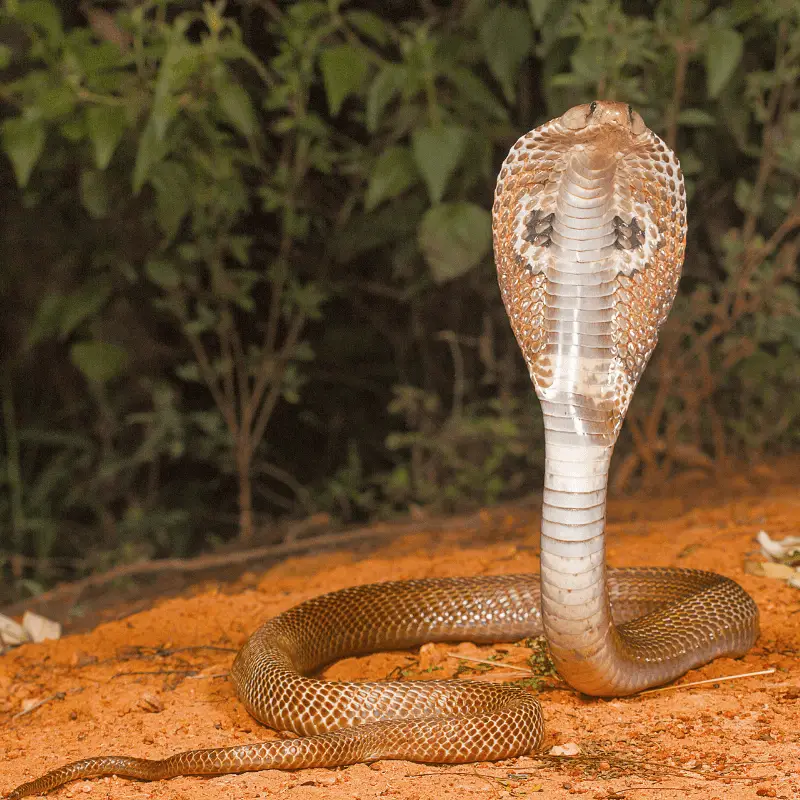The Indian Cobra is one of the most venomous snakes that can be found in the world. It belongs to the big four snake species that cause the most snakebite deaths in the Indian subcontinent. The tales of Indian Cobra have been intricately woven into the lives of the country’s people. You can find revered mention of this snake species in Indian mythologies and folklore.
Even today, the Indian Cobra is one of the snakes that you can see in the snake charmers’ wickerwork baskets. The colour and pattern of the snakes vary exceptionally across the range.
However, all Indian Cobras can be identified with their distinctive hood that they spread when threatened. Most of the specimens exhibit a distinctive hoof mark on the rear end of their hood. Let’s keep on reading this article to find out more about the deadly Indian Cobra.
Habitat
The Indian Cobras generally live in the plains and rainforests of the Indian subcontinent. You can find these snakes all over India, Sri Lanka, Pakistan, Bangladesh, Bhutan, the Southern Portion of Nepal and China. This snake species has also been observed in the Chitral Valley of the Drosh region. That indicates these snakes can also be found in the Kabul river valley region, located in the extreme eastern parts of Afghanistan.
Locations:
- India
- Sri Lanka
- Pakistan
- Bangladesh
- Bhutan
- Southern Portion of Nepal
- China
- Afghanistan
The interesting fact about Indian Cobras is that they live in a wide range of different geographical regions’ habitats. You can find these snakes in the plains, forests, rocky terrains, agricultural lands, wetlands, and villages. You can also find these snakes in the heavily populated outskirts of the cities.
The Indian Cobras can be found in places 6600 ft above sea level when it comes to altitudes. However, Indian cobras love water, and they are often found in areas with water bodies nearby. That might be one reason why these snakes are not found in the country’s desert region.
Appearance
The most prevalent physical feature of the Indian Cobra is perhaps its distinctive hood mark design. Another characteristic feature of this snake is the wide black band that appears on its neck’s underside. The hood mark consists of two half circles on either side of the hood, connected with a curved line. The Indian Cobra has black eyes, a broad head and neck and a medium-sized smooth scaled body. The colouring of the snakes varies extensively throughout the range.
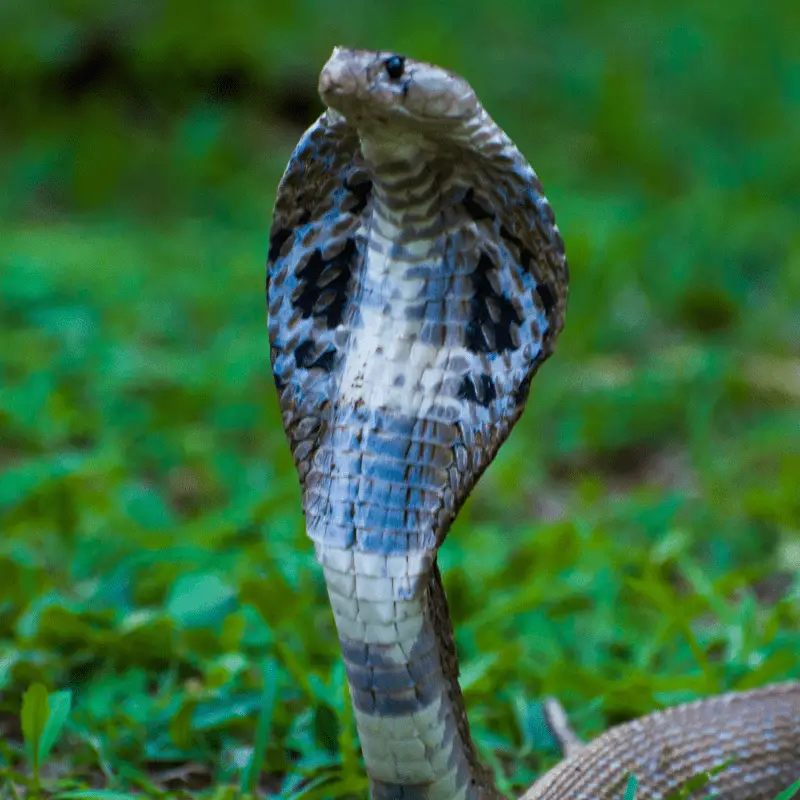
Front View
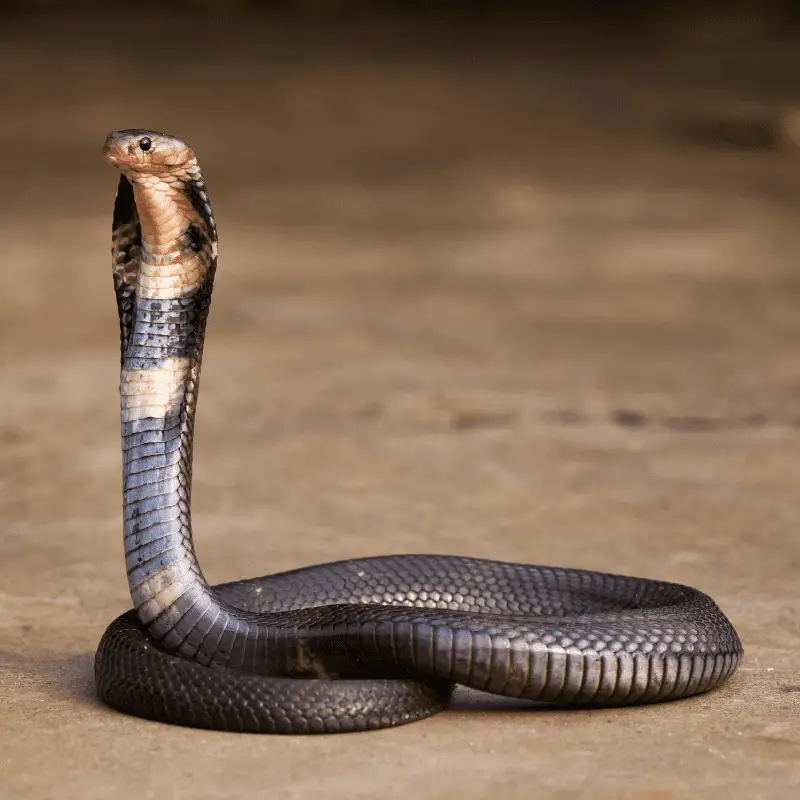
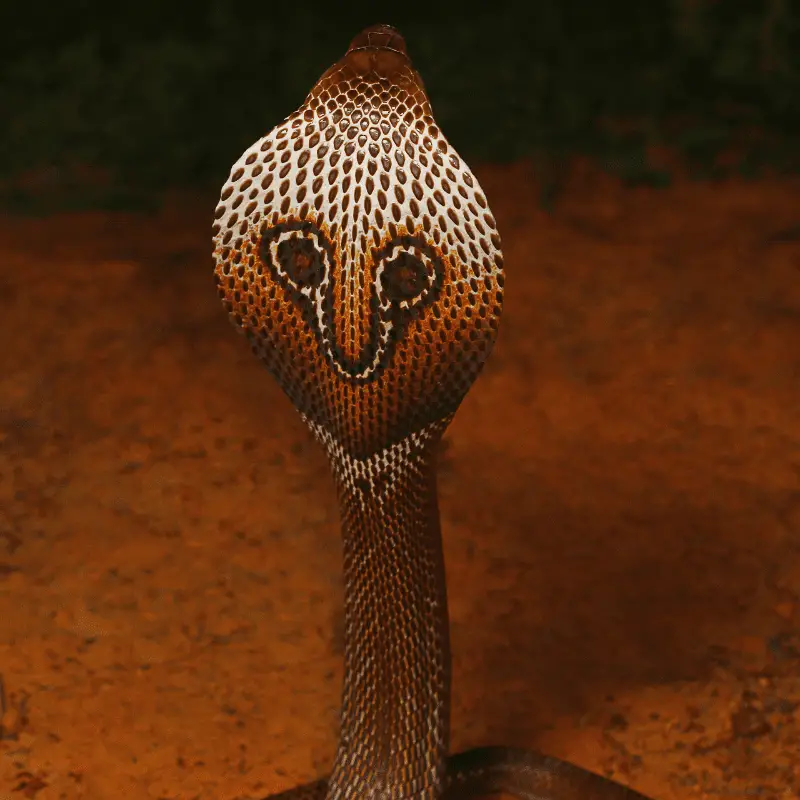
The underside scale colours of the Cobra can be yellow, grey, tan, reddish, brown, or black coloured. The Indian cobras can be identified by the salt and pepper specks that appear on the adult specimens’ bodies. These salt and pepper markings can be seen on the dorsal scales of the snakes.
The overall colouring of the snake can vary from black to creamy white to dark brown. The body of some snakes can be covered with spectacled yellow or white patterns, which create ragged band-like features.
Size
The Indian Cobras can grow up to 2.2 meters in length.
Lifestyle and Habits
The habits of the Indian Cobras are still unknown to the researchers. However, most Indian Cobras love to lead a solitary life. They are diurnal creatures. That means, like humans, Indian Cobras lead an active life during the day and rest at night. These snakes generally find shelter in tree hollows, holes in the river or pond embankments, rock piles, termite mounds, and small mammal dens. These snakes flare their hood when they feel threatened. Indian Cobras can lift one-third of their body off the ground when threatened. Even though it is a somewhat awkward position, these snakes can still move forward to strike.
Some of the species of Indian cobras can even spit venom at their attacker if they feel highly threatened by them. These snakes squeeze their venom glands in their mouth and force out the poison out of their fangs using pressure. In this way, some variations of the Indian Cobra can spit their venom at someone who is 2 metres (6.6 ft feet) away from them.
Thankfully, the Indian Cobras do not like much attention. They try to avoid humans whenever it is possible. Still, Indian Cobras are one of the four deadly snake species that cause most snakebite deaths in Asia.
Elapidae family
Indian Cobras are places in the Elapidae family which belong to the genus Naja. Josephus Nicolaus Laurenti first described this family of Elapidae in 1768. However, the Swedish Zoologist, botanist and physician Carl Linnaeus first mentioned this species in 1758.
Previously, scientists thought that the Indian Cobra was a single species that belonged to the same distribution as the King Cobra. However, biologists have declared recently that the old idea was wrong. They have discovered more than a dozen snake species in Asia that are different variants of the Indian Cobra. Some of these snake species are venom spitters, while others do not show the same trait.
Indian Cobra scientific name: Naja naja
Josephus Nicolaus Laurenti
The venom toxicity level also varies from one species to the next. The size of different variants of Indian Cobra differs as well. Most of them range between 1.25 meters to 1.75 meters. However, the variants found in Sri Lanka can grow more than 2 meters.
Venom
The Indian Cobra is one of the snake species responsible for human fatalities caused by snakebites in India. The venom of the Indian Cobras is highly toxic. It contains very powerful post-synaptic cardiotoxins and neurotoxins. Some enzymes in the venom help it to spread in the body of the victim faster. The venom these snakes can deliver in a single bite is enough to kill about 20 grown men.
The local symptoms of the snake bites include swelling in the bitten area. Other symptoms include drooping eyelids, weakened limbs and extreme salivation. As time passes, the victim will start sweating profusely along with continuous vomiting. The venom first paralyzes the muscles of the victims. In the most severe cases, snake bites can cause cardiac arrest or respiratory failures.
India Cobra Venom Symptoms:
- Swelling
- Drooping Eyelids
- Weakened Limbs
- Extreme Salivation
- Sweating
- Vomiting
- Muscles Paralyzed
- Cardiac Arrest
- Respiratory Failure
The venom of the Indian Cobra is one of the fast-acting ones. After the bite, the envenomation symptoms can start from 15 minutes to two hours. Indian Cora is responsible for hundreds of deaths per year. But, if proper treatment is promptly started, only 10% of snakebite attacks can be fatal. However, the researchers have shown that even without treatment and anti-venom injections, the mortality rates of the Indian Cobra bite is only 20% to 30%.
Venom Treatment
Generally, a polyvalent anti-venom is used for treating the snakebites of the Indian Cobra. Some of the local herbs, like Zedoary, are being tested for their effectiveness in treating snakebite victims.
Feeding Habits
Like their habitats, the feeding habits of Indian Cobra are varied as well. These snakes feed on different types of animals but mostly prefer small rodents. That is why these snakes can be found in heavily populated areas like villages or city skirts. These snakes do not hesitate to enter human dwellings, climb on rooftops or trees searching for rodents.
Indian Cobras also eat other small mammals, bird eggs and, if possible, birds. These snakes also eat lizards, toads, frogs and other snakes, including the venomous ones.
While catching their prey, the Indian Cobras bite quickly, injecting the prey with their highly toxic venom. Once that’s done, they wait till the snake becomes paralyzed or dead. Just like other snake species, the Indian Cobras also eat their prey as a whole.
Reproduction
The Indian Cobras are one of the oviparous snakes. That means male and female snakes mate to reproduce sexually. The gametes of the snakes join to create the eggs.
Even though most of the snakes across the world do not show any attachment to their offspring, it is not true for the Indian Cobras. The mother snake protects their eggs till they hatch. On the other hand, the male snakes do not have anything to do with their eggs or the hatchlings.
The females protect the eggs fearlessly from the predators and only leave their nest to feed. These snakes generally lay eggs in rat holes, termite mounds, hollow trees or in the ground.
At a time, a female snake can deliver somewhere between 8 to 45 eggs. The eggs require an incubation period of 50 to 70 days before hatching. The baby Indian Cobras use their egg tooth to tear through the shells of the egg. Just after getting out from their eggshells, the hatchlings can show the signature display of spreading their hood when threatened. The hatchlings measure about 8 to 12 inches (20cm to 30cm) in length. From the beginning, the hatchlings are independent with fully functional venom glands.
When do Indian Cobras lay their eggs?
The female Indian Cobras lay eggs between April and July each year.
Positive and Negative Economic Importance of Indian Cobra
Indian Cobra eats mice and rats, which are disease carriers. Not only that, these pests eat human food and can cause problems during cultivation. By consuming these pests, Indian Cobra helps people economically. Also, the venom of the Indian Cobra is used for making medicines. Some of the painkillers and anti-cancer drugs are made using the venom of the Indian Cobra.
However, the flip side of the coin is fearsome. The Indian Cobra is a highly venomous snake. One bite of the snake can be lethal. As these snakes hunt rodents that live near people, accidental encounters are pretty standard. In India alone, hundreds of people die from the bites of the Indian Cobra each year.
How long do Indian Cobras live?
The Indian Cobras have a substantially longer life. The average lifespan of the Indian Cobras is 17.1 years. However, in captivity, these snakes can live for more than 20 years.
Snake Charmers
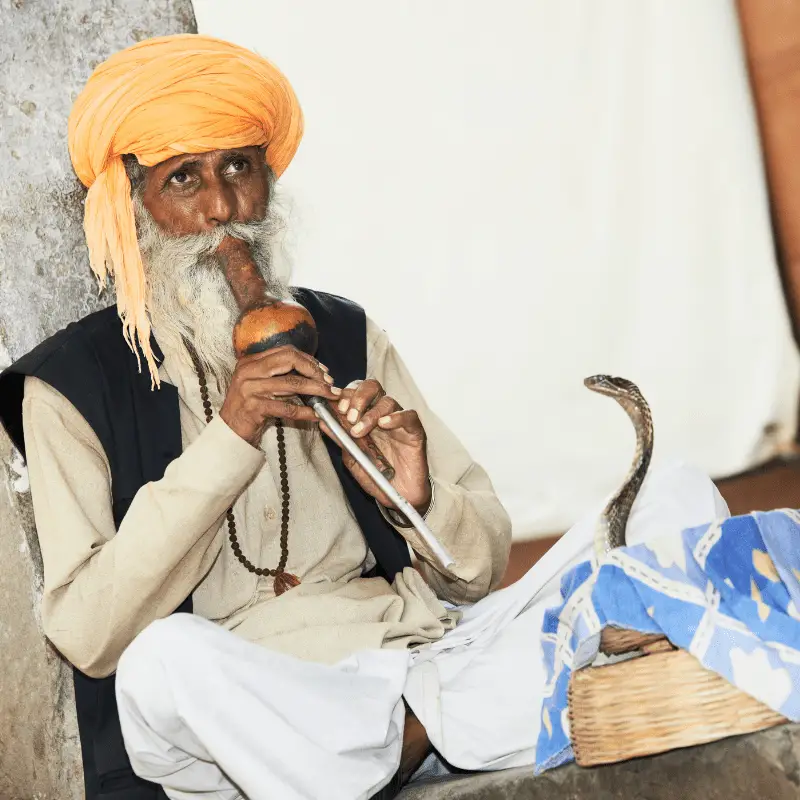
The Indian Cobra is the favourite of the snake charmers of Indian and other South-East Asian Countries. Even though the cobras can hear sounds, they are deaf to the general ambient noises. They hear the sounds sensing the vibration of the ground instead. Thus, the idea that the Indian Cobras dance, hearing the snake charmer’s flute’s tune, is nothing but a myth.
The snake charming in itself is a controversial practice. The snake charmers often capture the snakes from the wild and de-fearing them. Some of the charmers collect the venom of the snakes for making local medicines. The snakes are often tortured and kept in an unnatural environment just for entertainment. The swaying that you see has been taught by the snake charmers by using various methods. As the Indian Cobras only flare their hoods when threatened, the snake charmers use different tactics, like tapping their feet on the ground to create a sense of fear in the snake while showcasing them to the audience.
Threats
Even though the Indian Cobra is not an endangered species, it is undoubtedly a vulnerable one. These snakes face specific threats to their species, thanks to the deep-rooted fear for them. Other than that, these snakes are often killed for human consumption. A considerable number of these snakes die every year.
Illegal capture of this snake from the wild is another threat to this species. Along with the snake charmers, venom harvesters also catch the wild snakes to harvest venom and sell it in the market illegally. Indian Cobras are also captured from the wild for making illegal snake vines.
Heavy deforestation is yet another factor that has threatened the survival of the Indian Cobras in the last few years. Along with that, the Indian Cobras are captured and killed for their skin and international pet trades.
Conservation
Some of the south-east Asian countries have taken steps to protect these snakes. In Vietnam, the Indian King Cobras are a protected species. These snakes are also protected in India under the Indian Wildlife Protection Act (1972). To keep tabs on the wild snakes, the Indian Forest officials often put implants in the captive Indian Cobras before leaving them in the wild. The implants help the officials to identify the snakes and put a leash on the illegal wildlife trade.
Fun Facts
- There are various myths about Indian Cobras. In the Indian mythologies, the Indian Cobra has been identified as the king of all snakes, known as Vasuki.
- Even though the Indian Cobras love to hunt on the ground, they can climb trees or walls quite easily. More often than not, these snakes stalk their prey to the top of a house or a tree.
- Indian Cobras are not semi-aquatic, but they are decent swimmers. These snakes can swim for short distances without issues.

